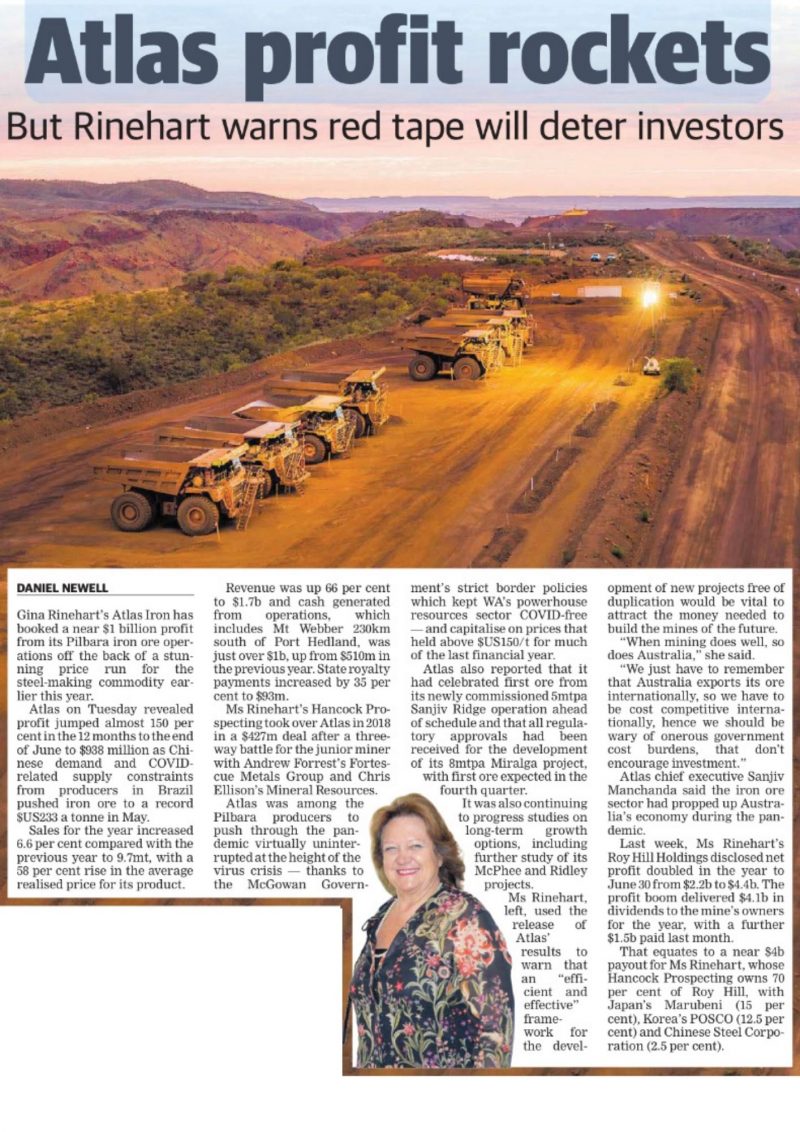ATLAS PROFIT ROCKETS
Article by Daniell Newell courtesy of the West Australian.
But Rinehart warns red tape will deter investors
Gina Rinehart’s Atlas Iron has booked a near $1 billion profit from its Pilbara iron ore operations off the back of a stunning price run for the steel-making commodity earlier this year.
Atlas on Tuesday revealed profit jumped almost 150 per cent in the 12 months to the end of June to $938 million as Chinese demand and COVIDrelated supply constraints from producers in Brazil pushed iron ore to a record $US233 a tonne in May.
Sales for the year increased 6.6 per cent compared with the previous year to 9.7mt, with a 58 per cent rise in the average realised price for its product.
Revenue was up 66 per cent to $1.7b and cash generated from operations, which includes Mt Webber 230km south of Port Hedland, was just over $1b, up from $510m in the previous year. State royalty payments increased by 35 per cent to $93m.
Ms Rinehart’s Hancock Prospecting took over Atlas in 2018 in a $427m deal after a threeway battle for the junior miner with Andrew Forrest’s Fortescue Metals Group and Chris Ellison’s Mineral Resources.
Atlas was among the Pilbara producers to push through the pandemic virtually uninterrupted at the height of the virus crisis thanks to the McGowan Government’s strict border policies which kept WA’s powerhouse resources sector COVID-free and capitalise on prices that held above $US150/t for much of the last financial year.
Atlas also reported that it had celebrated first ore from its newly commissioned 5mtpa Sanjiv Ridge operation ahead of schedule and that all regulatory approvals had been received for the development of its 8mtpa Miralga project, with first ore expected in the fourth quarter.
It was also continuing to progress studies on long-term growth options, including further study of its McPhee and Ridley projects.
Ms Rinehart, left, used the release of Atlas’ results to warn that an “efficient and effective” frame work for the development of new projects free of duplication would be vital to attract the money needed to build the mines of the future.
“When mining does well, so does Australia,” she said.
“We just have to remember that Australia exports its ore internationally, so we have to be cost competitive internationally, hence we should be wary of onerous government cost burdens, that don’t encourage investment.” Atlas chief executive Sanjiv Manchanda said the iron ore sector had propped up Australia’s economy during the pandemic.
Last week, Ms Rinehart’s Roy Hill Holdings disclosed net profit doubled in the year to June 30 from $2.2b to $4.4b. The profit boom delivered $4.1b in dividends to the mine’s owners for the year, with a further $1.5b paid last month.
That equates to a near $4b payout for Ms Rinehart, whose Hancock Prospecting owns 70 per cent of Roy Hill, with Japan’s Marubeni (15 per cent), Korea’s POSCO (12.5 per cent) and Chinese Steel Corporation (2.5 per cent).

